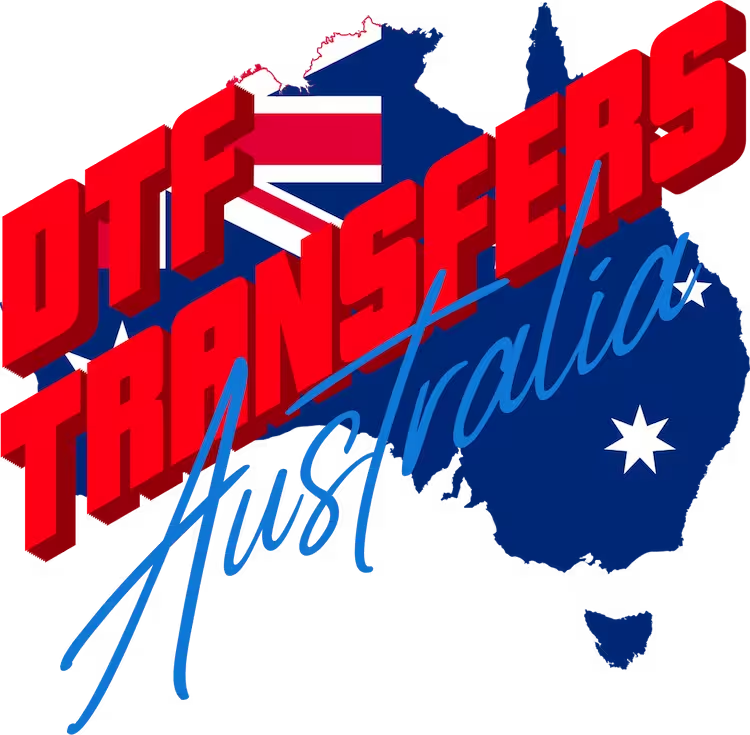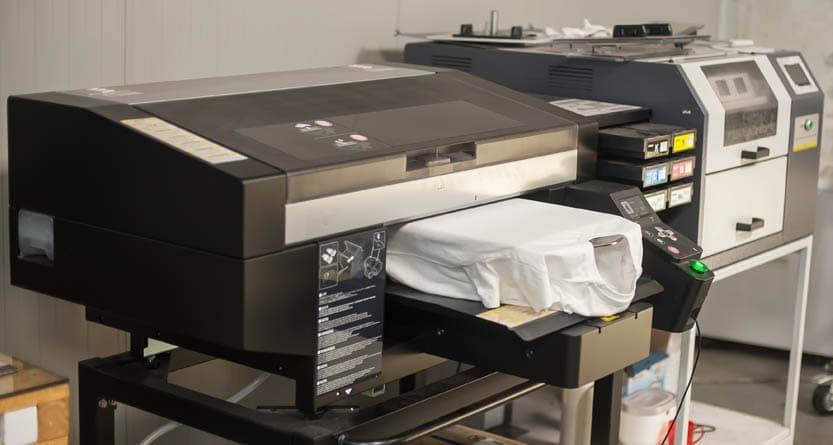All Posts, Direct To Film, Helpful Info
DTG Verses DTF, A Tale of Two Printing Techniques
Welcome to the vibrant world of garment printing, where innovation and creativity collide, transforming simple t-shirts into canvases of expression. Let explore two game-changing printing techniques that have been making waves in the industry: Direct To Garment (DTG) and Direct To Film (DTF).
DTG, has been a long-standing high-quality print method that has, detailed prints, and has been a go-to choice for many. On the other hand, DTF, is a relative newcomer, is quickly gaining popularity with its unique versatility and ease of use. But what happens when these two techniques intersect? Can a DTG printer produce DTF transfers? And how can this synergy revolutionise the way print-on-demand businesses operate, especially when dealing with challenging materials like polyester and blends?
In this comprehensive article, we’ll journey through the world of DTG Verses DTF, exploring their origins, workings, and unique strengths. We’ll delve into the innovative ways these techniques can complement each other, opening up new possibilities for businesses and individuals alike. We’ll also compare them head-to-head, analysing their pros, cons, cost-effectiveness, durability, and much more.
To top it all off, we’ll answer some of the most frequently asked questions about DTG Verses DTF, equipping you with a well-rounded understanding of these two printing powerhouses.
So, fasten up and prepare for an enlightening trip through this captivating topic of DTG Verses DTF. Let’s go!
Table Of Contents:
- The World of DTG (Direct To Garment)
- The Rise of DTF (Direct To Film)
- The Intersection of DTG and DTF
- DTG vs DTF – The Showdown
- The Verdict
- FAQ Section
- In Conclusion
The World of DTG (Direct To Garment)
The Emergence of DTG
In the landscape of garment printing, a technique emerged that was set to revolutionise the industry – Direct To Garment (DTG) printing. This method, which involves printing designs directly onto a garment, quickly gained popularity for its ability to reproduce intricate, high-resolution designs with a wide array of colours.
DTG: The Artist’s Canvas
Imagine being an artist, and your canvas is a plain white t-shirt. With DTG, you can bring your most complex and colourful designs to life. Whether it’s a vibrant landscape, a detailed portrait, or a whimsical pattern, DTG can handle it all with precision and clarity.
The DTG Process
The DTG process is straightforward and consists of three main steps:
- Preparation: The garment is pre-treated with a special solution to ensure the ink adheres properly. It’s then placed on a platen to keep it flat and steady during printing.
- Printing: The design is digitally sent to the DTG printer, which uses a special textile ink to print the design directly onto the garment. The printer works much like a regular inkjet printer, moving back and forth while dropping fine ink onto the t-shirt.
- Curing: After printing, the garment is heat-pressed or cured to ensure the ink is dry and the design is permanently affixed to the fabric.
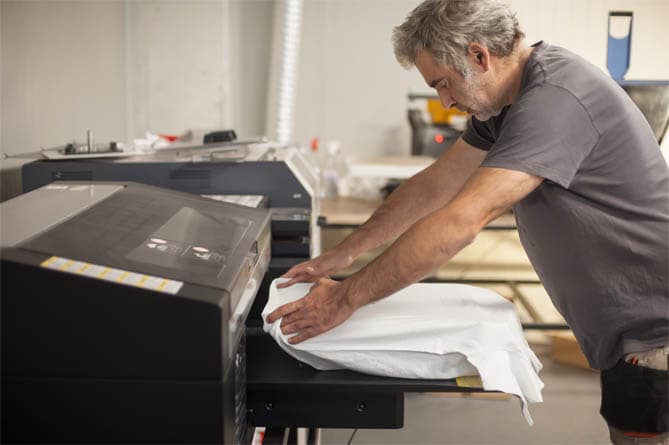
The Impact of DTG
DTG has been a game-changer, especially for small businesses and individual artists. It allows for low minimum orders (even one-off prints), with quick turnaround times, and high-quality results.
The Limitations of DTG
However, DTG is not without its limitations. It works best on 100% cotton fabrics and can struggle with synthetic materials, and with darker fabrics, the image may be less viberant. But what if there was a way to overcome these challenges? This brings us to DTF, a technique that’s been making a name for itself in the industry. But before we delve into the world of DTF, let’s explore how DTG and DTF can intersect.
The Rise of DTF (Direct To Film)
The Advent of DTF
In the ever-evolving world of garment printing, a new player has entered the arena – Direct To Film (DTF) printing. This innovative technique, although relatively new, is quickly gaining traction for its unique versatility and ease of use.
DTF: A New Approach
Unlike DTG, which prints directly onto the garment, DTF prints onto a special film first. This film, carrying the design, is then transferred onto the garment using heat and pressure. This unique approach opens up a world of possibilities, allowing printing on a wider range of materials and colours with more vibrant colours.
The DTF Process
The DTF process, while slightly more complex than DTG, offers its own set of advantages. Here’s how it works:
- Printing: The design is printed onto a special film using a DTF printer. Unlike DTG, the design is printed in reverse, as it will be flipped when transferred onto the garment. The Colour is printed first and White is printed secondary.
- Coating: The printed film is then coated with a layer of adhesive powder. This powder will help the design adhere to the garment during the transfer process.
- Curing: The film is then cured, or dried, to ensure the adhesive powder sticks to the ink.
- Transfer: The film is placed onto the garment, and heat and pressure are applied. This causes the design to transfer from the film onto the garment.
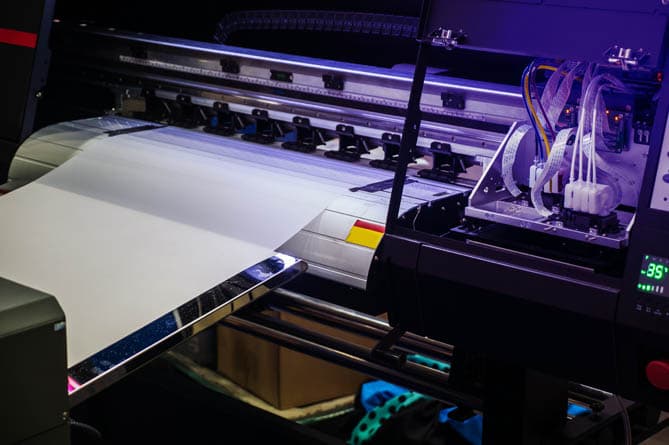
The Impact of DTF
DTF has been a boon for businesses looking to expand their product range. It allows for printing on a variety of materials, including polyester and blends, which are typically challenging if not impossible for for DTG. This means businesses can offer more variety to their customers, from cotton t-shirts to polyester sports jerseys.
The Future of DTF
As DTF continues to grow in popularity, it’s set to redefine the boundaries of garment printing. But how does it stack up against the established DTG technique? Lets delve into the intersection of DTG and DTF, and explore how these techniques can complement each other.
The Intersection of DTG and DTF
DTG and DTF: A Powerful Combination
In the world of garment printing, DTG and DTF might seem like competitors. However, when these two techniques intersect, they can create a powerful combination that leverages the strengths of both methods.
DTG Printers and DTF Transfers
Interestingly, a DTG printer can be used to create DTF transfers. This opens up a world of possibilities for businesses that already have DTG printers. By using their existing equipment, they can expand their offerings to include DTF transfers, providing more options for their customers.
The Process
The process of creating DTF transfers with a DTG printer is similar to the standard DTF process. The design is printed onto a special film, coated with adhesive powder, cured, and then ready to be transferred onto a garment. The main difference is that the design is printed using the DTG printer instead of a dedicated DTF printer.
DTF: A Solution for DTG Limitations
One of the main advantages of DTF is its ability to print on a wider range of materials, including polyester and blends. These materials are typically challenging for DTG, which works best on 100% cotton fabrics. Therefore, DTF can be a game-changer for DTG print-on-demand businesses, allowing them to cater to a broader market.
DTF and DTG: Complementary Techniques
DTG and DTF are not just standalone techniques, but can be complementary. By understanding the strengths and limitations of each method, businesses can make the most of both techniques, offering a wider range of products and catering to a broader customer base. Next, we’ll dive deeper into the comparison between DTG and DTF, exploring their pros and cons in detail.
DTG vs DTF – The Showdown
DTG and DTF: A Side-by-Side Comparison
As we delve into the world of garment printing, it’s essential to compare DTG and DTF side-by-side. While both techniques have their unique strengths, they also have their own set of challenges.
Quality and Detail
DTG has historically been the go-to choice for high-quality, detailed prints, given its ability to seamlessly replicate complex designs with a vast spectrum of colours. However, DTF is quickly closing the gap, showing significant enhancements at an accelerated rate. With the progression of technology, DTF is also stepping up its game in producing top-tier prints, making the decision between the two a tight contest.
Material Compatibility
In terms of material compatibility, DTF takes the lead. While DTG works best on 100% cotton fabrics, DTF can print on a wider range of materials, including polyester and blends. This versatility makes DTF a more flexible option for businesses looking to offer a broader range of products.
Look and Feel
There’s a distinct difference in the appearance and texture of DTG and DTF prints. The aesthetic and sensation of DTG prints are akin to those of acrylic screen-printed t-shirts, whereas DTF prints are reminiscent of Plastisol screen-printed t-shirts. People’s preferences may vary, but both methods yield high-quality results. However, it’s important to remember that using inexpensive film and powder can result in a plasticky feel to the transfers. Thus, it’s crucial to choose high-grade film and powder when producing your transfers.
Cost and Efficiency
On the cost and efficiency front, both techniques have their pros and cons. DTG is known for its quick turnaround times and low minimum orders, making it ideal for small businesses and one-off prints. On the other hand, DTF, while requiring a more complex process, can be more cost-effective for larger orders.

Durability
When it comes to durability, both DTG and DTF prints can last a long time with proper care. However, the longevity of the print can be influenced by factors such as the quality of the ink, the material of the garment, and how well the washing and care instructions are followed.
A Quick Overview
In the showdown between DTG and DTF, it’s clear that both techniques have their place in the garment printing industry. The choice between the two often comes down to the specific needs and capabilities of the business.
The Verdict
Choosing the Right Technique
With garment printing, choosing the right technique can make all the difference. While both DTG and DTF have their unique strengths, the choice often comes down to your specific needs and resources.
When to Choose DTG
DTG is an excellent choice for small businesses or individuals looking for high-quality, detailed prints with low minimum orders. If you’re dealing primarily with 100% cotton fabrics and lighter coloured garments, DTG could be the perfect fit for you.
When to Choose DTF
On the other hand, DTF shines when it comes to versatility. If you’re looking to print on a wider range of materials, including polyester and blends, DTF could be your go-to technique. It’s also a great option if you’re looking to expand your product range and cater to a broader market.
The Power of Both
But remember, DTG and DTF are not mutually exclusive. In fact, they can complement each other beautifully. By leveraging the strengths of both techniques, you can offer a wider range of products and cater to a broader customer base.
The Future of Garment Printing
As technology continues to evolve, we can expect both DTG and DTF to grow and improve. The future of garment printing is bright, and it’s an exciting time to be part of this dynamic industry.
FAQ Section
Is DTF more expensive than DTG?
The cost of DTF and DTG can vary based on several factors, including the cost of equipment, ink, materials, and the size of the order. Generally, DTG might have lower upfront costs, making it a popular choice for small businesses and individuals. However, DTF can be more cost-effective for larger orders and offers the flexibility to print on a wider range of materials.
What are the pros and cons of DTG vs DTF?
DTG pros include high-quality, detailed prints, quick turnaround times, and low minimum orders. However, it works best on 100% cotton fabrics and can struggle with darker garments or synthetic materials.
DTF pros include the ability to print on a wider range of materials and colours, including polyester and blends. However, the DTF process is slightly more complex and may require a larger initial investment in equipment and materials.
What is the downside of DTF?
While DTF offers many advantages, it does have a few downsides. The process is more complex than DTG, requiring additional steps such as applying adhesive powder and transferring the design from film to garment. Additionally, the initial investment for DTF equipment and materials can be higher than DTG.
How long do DTF prints last?
The longevity of DTF prints can be comparable to DTG prints when cared for properly. However, the durability can be influenced by factors such as the quality of the ink, the material of the garment, and the washing and care instructions followed.
Does DTG printing come off?
With proper care, DTG prints can last a long time. However, like any printed garment, the design may fade over time with repeated washing and wear. To maximize the lifespan of DTG prints, it’s recommended to wash the garment inside out in cold water and avoid high-temperature drying.
Why is DTF so popular?
DTF is gaining popularity due to its versatility. It allows for printing on a wider range of materials and colours, including fabrics that are typically challenging for DTG, such as polyester and blends. This flexibility makes DTF a popular choice for businesses looking to expand their product range.
Does DTG hold up?
Yes, DTG prints can hold up well with proper care. The prints are durable and can withstand repeated washing and wear. However, like any printed garment, the design may fade over time. To maximise the lifespan of DTG prints, it’s recommended to follow the proper washing and care instructions.
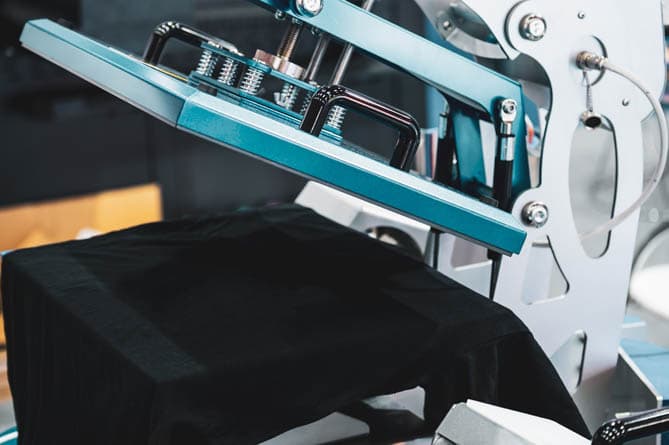
In Conclusion
What have we found out about DTG Verses DTF, lets wrap it all up.
In the captivating world of garment printing, both Direct To Garment (DTG) and Direct To Film (DTF) techniques have carved out their unique niches. Each brings a set of strengths to the table, and understanding these can help businesses and individuals make informed decisions.
DTG, with its ability to produce high-quality, detailed prints, is a fantastic choice for small orders and 100% cotton fabrics. On the other hand, DTF, with its versatility and ability to print on a wider range of materials, offers exciting possibilities for those looking to expand their product range.
But the real magic happens when these two techniques intersect. By leveraging the strengths of both DTG and DTF, businesses can offer a wider range of products and cater to a broader customer base.
As we look to the future, it’s clear that both DTG and DTF have exciting paths ahead. As technology continues to evolve, we can expect these techniques to grow and improve, pushing the boundaries of what’s possible in garment printing.
We hope this guide has provided you with a deeper understanding of DTG and DTF. Whether you’re a seasoned professional in the printing industry, a budding entrepreneur, or simply a curious mind, we invite you to explore the offerings of DTF Transfers Australia and discover the potential of these innovative printing techniques. Happy printing!
